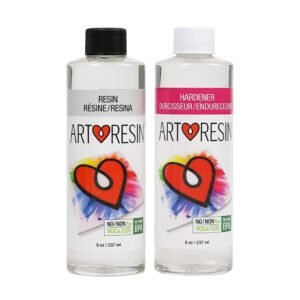
1. Types of Resin Coasters:
- Epoxy Resin: Known for its clear finish and non-toxic nature, it’s ideal for decorative, low-heat coasters.
- Polyurethane Resin: Offers excellent durability and heat resistance, making it perfect for functional coasters.
- Polyester Resin: Budget-friendly and quick curing, though it may compromise on clarity and ease of use.
2. Durability and Wear Resistance:
Durability is crucial for resin coasters experiencing heavy usage. For scratch-resistant surfaces, look to polyurethane resin. Ensure appropriate thickness and curing for long-lasting results.
3. Heat Resistance:
Epoxy resins may not handle high temperatures well, while polyurethane and polyester excel here. Prioritize heat resistance based on your usage needs.
4. Clarity and Aesthetics:
Epoxy resin stands out with a crystal-clear finish, perfect for vibrant, decorative designs. Polyurethane and polyester may not match this clarity, sometimes appearing amber or cloudy.
5. Ease of Use:
Epoxy is user-friendly with a long working time, catering to beginners. Polyurethane and polyester require quicker action due to shorter curing times.
6. Curing Time:
Epoxy resin cures the slowest (up to 72 hours), whereas polyurethane and polyester cure faster. Choose based on project timelines.
7. Cost Considerations:
Polyester is the most budget-conscious choice. Polyurethane offers a balance between performance and cost; epoxy, while costly, provides superior clarity.
Step-by-Step Guide to Making Resin Coasters
- Prepare Your Work Area: Ensure good ventilation and wear gloves and masks.
- Mix the Resin: Follow specific mixing ratios for your chosen resin.
- Add Color/Embellishments: Incorporate dyes or embedded items as desired.
- Pour into Molds: Ensure even distribution and tap molds to release air bubbles.
- Eliminate Air Bubbles: Use a heat gun to smooth out the surface.
- Let the Resin Cure: Cover and allow curing as per manufacturer’s guidelines.
- Demold and Finish: Sand edges if needed for a smooth finish.
FAQs
- Best Resin for Beginners? Epoxy due to its ease of use and clear finish.
- Most Heat-Resistant Resin? Polyurethane withstands high temperatures well.
- Most Durable Resin? Polyurethane excels with durability.
- Does Resin Yellow? Yes, especially non-UV-resistant variants.
- Curing Time? Epoxy takes longest, while others cure faster.
Conclusion
Choosing the suitable resin aligns with your project’s needs: clarity, heat resistance, or cost-efficiency. Use epoxy for aesthetic projects, polyurethane for durability, and polyester for budget-friendly solutions. Following best practices ensures your resin coasters are both beautiful and functional.

